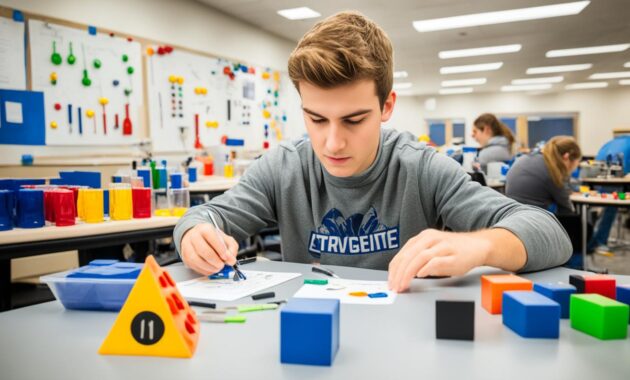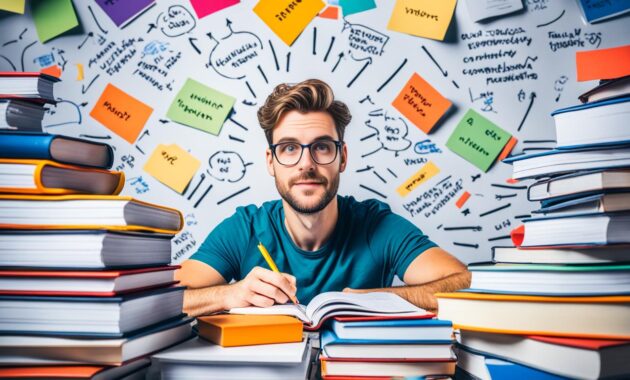Tailoring Study Techniques For Visual Learners education to a child’s learning style is crucial in maximizing their potential. For visual learners, this means adopting study techniques that align with their preference for visual stimuli. Visual learners thrive when they can see and observe information, making use of visual aids and color coding to enhance their understanding and retention. Research suggests that visual learners often struggle with traditional teaching methods that rely heavily on lectures and classroom discussions.
In this article, we will explore effective study tips and strategies specifically designed for visual learners. Whether you’re a student, a parent, or an educator, you’ll discover valuable insights to maximize learning for visual learners. So, let’s dive in and unlock the secrets to success for visual learners!
Key Takeaways:
- Visual learners benefit from using visual aids and color coding.
- Retaining information is easier for visual learners when they can visualize concepts or create mental maps.
- Interactive tools, such as educational videos and tactile materials, appeal to visual learners’ preferred learning style.
- Visual learners often retain information best when it is organized visually, such as through charts, diagrams, or concept maps.
- Using a combination of visual and auditory techniques can be particularly effective for visual learners.
Understanding Learning Styles: Visual, Auditory, and Kinesthetic
Learning styles play a crucial role in how individuals process and retain information. There are three main learning styles: visual, auditory, and kinesthetic. Understanding these styles can help tailor educational experiences to meet the needs of different learners.
Visual learners prefer to learn through seeing and observing. They benefit from visual aids such as charts, diagrams, and images. By incorporating color coding and utilizing visual elements, visual learners can enhance their understanding and retention of information.
Auditory learners, on the other hand, learn best through listening and hearing information. They thrive in an environment that provides verbal instructions, engages in discussions, and incorporates rhymes and songs. An auditory learner’s comprehension and retention are enhanced through sound-based educational games and opportunities for oral presentations.
Kinesthetic learners thrive on hands-on experiences and physical activities. They learn best by actively engaging with the material through role-play, simulations, and multi-sensory techniques. By incorporating movement breaks and interactive learning methods, kinesthetic learners can enhance their understanding and retention.
While most individuals have a combination of these learning styles, they usually lean towards one dominant style. Observing a child’s learning style can help tailor their educational experiences to their individual preferences. By catering to their preferred learning style, educators can create an environment that maximizes their learning potential.
Understanding learning styles and their implications can provide valuable insights into how individuals process information. By identifying and leveraging an individual’s learning style, educators can employ effective techniques that engage and cater to their preferences, resulting in a more fruitful learning experience.
Identifying Your Child’s Learning Style
Identifying your child’s learning style is crucial to tailor their education and maximize their learning potential. Every child has a unique way of processing information and retaining knowledge. By understanding their individual learning style, you can provide a personalized approach that aligns with their preferences and enhances their understanding.
When identifying your child’s learning style, it’s important to pay attention to their preferences and patterns in behavior. Observe how they interact with different learning materials and activities. Do they prefer visual cues, such as diagrams or videos? Or do they thrive in hands-on experiences and physical activities?
Encouraging self-reflection is another effective way to identify your child’s learning style. Encourage them to reflect on their own learning experiences and identify the methods that have worked best for them. This self-awareness will provide valuable insights into their preferred learning methods.
Experimentation is key in identifying your child’s learning style. Try different teaching methods and approaches to see how your child responds. Introduce visual aids, auditory cues, and kinesthetic activities to explore how they engage with each one. By experimenting with various techniques, you can uncover the methods that resonate most with your child.
Communication with teachers is essential for understanding your child’s learning style. Teachers can provide valuable feedback and insights into your child’s performance in the classroom. They can observe how your child engages with different instructional methods and share their observations and recommendations.
Remember, identifying your child’s learning style is an ongoing process. It may take time to accurately determine their preferences and strengths. Be patient and open-minded as you explore different strategies to support their learning journey.

“Every child is a unique learner, and by understanding their individual learning style, we can create an environment that supports their educational growth and success.”
Study Tips for Visual Learners
Visual learners have a unique way of processing information, and incorporating study techniques that cater to their learning style can greatly enhance their understanding and retention of information. Here are some effective study tips specifically designed for visual learners:
- Utilize visual aids: Visual learners often benefit from using visual aids such as charts, graphs, and diagrams to help organize information and create visual representations of concepts.
- Incorporate color coding: Color coding can be a helpful tool for visual learners in organizing and categorizing information. Assigning different colors to different topics or concepts can make studying more engaging and memorable.
- Encourage note-taking: Taking notes allows visual learners to actively process and summarize information. They can try using different formatting techniques, such as bullet points or mind maps, to make their notes more visually appealing and easier to review.
- Provide hands-on activities: Engaging in hands-on activities, such as experiments or creating models, can help visual learners solidify their understanding of complex concepts by allowing them to physically interact with the material.
- Utilize educational apps: There are various educational apps available that cater specifically to visual learners. These apps often incorporate interactive visual elements, quizzes, and flashcards to make learning more engaging and effective.
- Use flashcards with images: Flashcards are a versatile study tool, and visual learners can take it a step further by adding relevant images or visuals to their flashcards. This can help them associate images with specific concepts or terms, assisting in recall.
- Teach visualization techniques: Visual learners can benefit from incorporating visualization techniques into their study routine. They can create mental images or imagine scenarios related to the content they are studying, which helps in retaining and recalling information.
By implementing these study tips, visual learners can optimize their learning experience and make the most out of their visual learning style. Remember to personalize these techniques based on individual preferences and learning needs.

“The mind is like a canvas, and visual learners paint the picture of knowledge through visual aids and techniques.” – Study Expert
Study Tips for Auditory Learners
For auditory learners, engaging in active listening is key to enhancing comprehension and retention of information. Here are some study tips specifically tailored for auditory learners:
- Utilize verbal instructions: Auditory learners benefit from receiving information through spoken words. When studying, seek out study materials that provide clear and concise verbal instructions.
- Participate in discussions: Engaging in discussions allows auditory learners to process information by listening and speaking. Join study groups or engage in conversations about the material to reinforce your understanding.
- Incorporate rhymes and songs: Auditory learners often respond well to rhythm and melody. Create rhymes or songs that summarize key concepts, making it easier to remember and recall information.
- Create recorded study materials: Recording study materials, such as reading textbooks or reviewing notes, allows auditory learners to listen to the information repeatedly for better understanding and retention.
- Play sound-based educational games: Incorporate interactive and engaging sound-based educational games into your study routine. These games make learning enjoyable while reinforcing important concepts.
- Provide opportunities for oral presentations: Giving oral presentations on the subject matter helps auditory learners solidify their understanding and express their knowledge in a meaningful way.
Remember, everyone’s learning style is unique, so feel free to experiment with these study tips and find the techniques that work best for you as an auditory learner.

Study Tips for Kinesthetic Learners
Kinesthetic learners thrive on hands-on activities and physical experiences. To support their unique learning style, incorporating certain study tips can enhance their understanding and retention of information.
Hands-on Activities
Engaging in hands-on activities is key for kinesthetic learners. Experiment with interactive materials, manipulatives, and practical tasks that allow them to actively engage with the subject matter. For example, during a science lesson, encourage them to perform experiments, build models, or participate in simulations. This approach enables them to connect concepts with real-world applications.
Movement Breaks
Kinesthetic learners benefit from movement breaks during study sessions. Allowing them to stretch, walk, or engage in light physical activity helps them maintain focus and stay energized. These brief breaks serve as a reset and enable kinesthetic learners to process information more effectively.
Multi-Sensory Techniques
Utilize multi-sensory techniques to cater to kinesthetic learners’ preferences. Incorporate visual, auditory, and tactile elements into their study materials. For example, when learning new vocabulary words, encourage them to write the words, say them out loud, and associate them with gestures or actions. This holistic approach engages multiple senses, reinforcing the learning experience.
Role-Play and Simulations
Encourage kinesthetic learners to participate in role-play and simulations. This active learning technique allows them to step into different perspectives, scenarios, or historical events. Whether it’s reenacting a significant event or assuming the role of a character from a novel, these immersive experiences deepen their understanding and bring abstract concepts to life.
| Study Tips for Kinesthetic Learners |
|---|
| Engage in hands-on activities |
| Take regular movement breaks |
| Incorporate multi-sensory techniques |
| Participate in role-play and simulations |

By implementing these study tips tailored to kinesthetic learners, educators and parents can empower them to excel academically, tap into their full potential, and broaden their understanding through their preferred hands-on approach.
Study Tips for Reading/Writing Learners
Reading/writing learners have a preference for the written word, making note-taking and creating study guides essential study techniques. These strategies enable reading/writing learners to organize and reinforce their understanding of the material. Here are some effective study tips specifically tailored to reading/writing learners:
- Note-taking: Take comprehensive notes during lectures, class discussions, and while reading textbooks. Highlight key points and jot down relevant details to reinforce your knowledge. Use abbreviations and symbols to capture information efficiently.
- Creating study guides: Summarize your notes and other study materials to create concise study guides. Organize the information in a logical and structured manner to enhance understanding and facilitate quick review prior to exams or assignments.
- Writing and rewriting: Practice writing and rewriting concepts and ideas in your own words. This process helps reinforce your understanding and aids in long-term retention. Try explaining the material to someone else or teaching it as if you were the instructor.
- Word association: Use word association techniques to connect new information with familiar words or concepts. Create mental links between related terms to improve memory and recall. Mnemonic devices and acronyms can also be effective for memorizing important details.
By employing these study tips, reading/writing learners can optimize their learning experience and excel in their academic pursuits.

“Effective note-taking, creating study guides, practicing writing and rewriting, and using word association techniques are study tips that cater to the preferences of reading/writing learners. These strategies help organize and reinforce understanding, leading to improved academic performance. “
Identifying Your Learning Style
Understanding your learning style is essential for tailoring your educational experiences to suit your preferences and maximize your learning potential. By identifying your learning style, you can adapt your study techniques, utilize effective strategies, and create a personalized learning journey. Here are some steps to help you identify your learning style:
- Self-assessment: Reflect on how you prefer to learn, whether through visual aids, listening to lectures, or engaging in hands-on activities. Consider your strengths and preferences when processing information.
- Learning style inventories: Take advantage of learning style inventories available online or through educational resources. These assessments can provide insights into your dominant learning style and help guide your study techniques.
- Experimentation: Try different learning approaches and strategies. Explore visual learning techniques, auditory methods, kinesthetic activities, and reading/writing practices. Observe how each approach impacts your understanding and retention of information.
- Seeking feedback: Reach out to teachers, mentors, or peers for feedback on your learning style. They can offer insights based on their observations and provide suggestions for improvement.
By actively engaging in self-assessment, utilizing learning style inventories, experimenting with different approaches, and seeking feedback, you can better understand your learning style and tailor your learning experiences to suit your individual needs.
Tailoring Your Learning Journey
To maximize your learning potential, it’s important to tailor your learning journey according to your unique learning style. By incorporating strategies that align with your preferred way of learning, you can enhance your understanding, retention, and overall academic success. Let’s explore how different learning styles can be catered to:
Visual Learners
Visual learners thrive when presented with visual aids and color coding. Incorporate diagrams, charts, and infographics into your study materials to help you visualize and understand complex concepts. Use color coding to organize information and make key points stand out.
Auditory Learners
For auditory learners, lectures and discussions are highly effective. Seek opportunities to engage in active listening and participate in group discussions. Record study materials and listen to them repeatedly to reinforce your understanding. Sound-based educational games and oral presentations can also be valuable learning tools.
Kinesthetic Learners
Kinesthetic learners learn best through physical movement and hands-on activities. Incorporate practical experiments, role-play, and simulations into your learning process. Take regular movement breaks to keep your mind engaged and enhance your understanding of the subject matter.
Reading/Writing Learners
If you’re a reading/writing learner, focus on note-taking and creating comprehensive study guides. Write and rewrite information to reinforce your knowledge. Utilize word association techniques to remember key concepts. Practice summarizing complex ideas in your own words.
Multimodal Learners
As a multimodal learner, you have the flexibility to adapt your learning approach based on the situation. Mix and match different learning methods to find what works best for you. Combine visual aids, auditory resources, hands-on activities, and reading/writing techniques to create a well-rounded learning experience.
Also Read:- Importance Of Past Papers : Unlocking Academic Success Through Strategic Preparation
Remember, the key to a successful learning journey lies in tailoring your approach to match your learning style. By understanding your preferences and incorporating suitable strategies, you can optimize your learning experience and achieve your educational goals.
| Learning Style | Preferred Strategies |
|---|---|
| Visual Learners | Visual aids, color coding, diagrams, infographics |
| Auditory Learners | Lectures, discussions, recorded materials, oral presentations |
| Kinesthetic Learners | Hands-on activities, practical experiments, movement breaks |
| Reading/Writing Learners | Note-taking, study guides, writing and rewriting, word association |
| Multimodal Learners | Combining different strategies based on preferences |
Conclusion
Understanding and tailoring study techniques for visual learners is crucial for maximizing their learning potential. Visual learners have a preference for learning through seeing and observing, and they benefit from incorporating visual aids, color coding, and hands-on activities into their study routines. These strategies help visual learners better understand and retain information, allowing them to unlock their full potential and achieve academic success.
By customizing their learning journey to their visual learning style, visual learners can optimize their study methods and enhance their learning experience. Tailoring their approach to align with their individual preferences and strengths will help them effectively process and retain information. Whether it’s using diagrams and visual representations, organizing information with color coding, or engaging in hands-on activities, visual learners can tailor their studying to maximize their learning potential.
It is important to note that while these strategies are effective for visual learners, every learner is unique, and what works for one may not work for another. It’s essential for students to identify their preferred learning style and experiment with different techniques to find what works best for them. By understanding their learning style and applying tailored study methods, learners can optimize their learning experience and achieve their academic goals.
FAQs
Q: What is visual learning?
A: Visual learning is a learning style where information is best understood when presented in a visual format such as diagrams, charts, infographics, and educational videos.
Q: How can visual learners benefit from tailored study techniques?
A: Visual learners can benefit from study techniques that incorporate visual aids, color coding, interactive materials, and diagrams, which help enhance their learning experience and retention of information.
Q: Why is it important to use color in study materials for visual learners?
A: Using color in study materials can help visual learners better organize and remember information, as colors can help convey meaning and create associations that aid in learning.
Q: What are some common strategies to help visual learners study effectively?
A: Some common strategies for visual learners include using flashcards, creating visual summaries, making use of educational videos, and utilizing diagrams or charts to represent information.
Q: How can tutors support visual learners in their studies?
A: Tutors can support visual learners by providing visual aids, helping them create study materials in a visual format, and incorporating interactive learning activities that cater to their visual learning style.
Q: Are there any potential distractions for visual learners while studying?
A: Yes, potential distractions for visual learners while studying may include cluttered study environments, visual stimuli that are unrelated to the subject, and lack of proper organization of study materials.
Q: Can visual learning techniques be combined with auditory learning methods?
A: Yes, visual learning techniques can be combined with auditory learning methods to create a more comprehensive learning experience that caters to both visual and auditory learners.
Source Links
- https://londongoverness.com/unlocking-your-childs-learning-style-tailoring-education-for-success/
- https://flexcollegeprep.com/study-tips-for-different-learning-styles/
- https://www.linkedin.com/pulse/discovering-your-learning-style-key-unlocking-full-potential-wotton